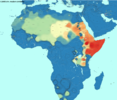The alchemist
VIP
The Nubian DNA from the long-awaited Balkan Roman study was delayed for two years plus since the drop of pre-print is out:

The study claims he was passingly modeled as Kenyan Iron Age with Kulubnarti Christian Nubian profiles. We can interpret this as exceeding Cushitic DNA than those Medieval Nubians in addition to a Nubian structure. I assume it was 60% Cushtic.

Pre-print PCA (they excluded Kulubnarti plotting on the published paper) highlights the Cushitic shift from the general Christian Nubian cluster:

Factoring in his uniparentals, it looked like nothing that deviates from the extant Somali with L2a1j and E-V32, barring potential different sub-mutational structuring.
I'm not sure if the Kenyan Iron Age was an intelligent application. All I can say is that it might have elevated Nilotic ancestry, relative to Kulubnartis that had predominantly Saharan-type sub-structure:

The sources utilized were simulated leaks for Ancient Egyptian samples, OK, OMK, and MK (questionable how they coordinated those, but that's another discussion, lol). 'Saharan' stands for Toubou, which maximizes such ancestry (incl. Zaghawa types). Cushitic is Elmenteitan, with a personal southern Somalia sample that is arguably one of the "purest."
With regards to modern Sudanese Nubians, they got slightly elevated Dinka-like ancestry above Saharan.
Interestingly, he might have had connections to Nabateans. It puts an insight into the northeast African globalized interconnectivity within the Arab economic sphere:

This better end up in G25. I'll be heated if they drop this because of some bogus claim about low coverage when it has been years of waiting.
The study claims he was passingly modeled as Kenyan Iron Age with Kulubnarti Christian Nubian profiles. We can interpret this as exceeding Cushitic DNA than those Medieval Nubians in addition to a Nubian structure. I assume it was 60% Cushtic.
Pre-print PCA (they excluded Kulubnarti plotting on the published paper) highlights the Cushitic shift from the general Christian Nubian cluster:
Factoring in his uniparentals, it looked like nothing that deviates from the extant Somali with L2a1j and E-V32, barring potential different sub-mutational structuring.
I'm not sure if the Kenyan Iron Age was an intelligent application. All I can say is that it might have elevated Nilotic ancestry, relative to Kulubnartis that had predominantly Saharan-type sub-structure:
The sources utilized were simulated leaks for Ancient Egyptian samples, OK, OMK, and MK (questionable how they coordinated those, but that's another discussion, lol). 'Saharan' stands for Toubou, which maximizes such ancestry (incl. Zaghawa types). Cushitic is Elmenteitan, with a personal southern Somalia sample that is arguably one of the "purest."
With regards to modern Sudanese Nubians, they got slightly elevated Dinka-like ancestry above Saharan.
Interestingly, he might have had connections to Nabateans. It puts an insight into the northeast African globalized interconnectivity within the Arab economic sphere:
This better end up in G25. I'll be heated if they drop this because of some bogus claim about low coverage when it has been years of waiting.
You don't have permission to view the spoiler content.
Log in or register now.

